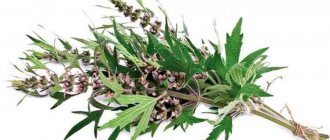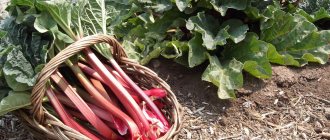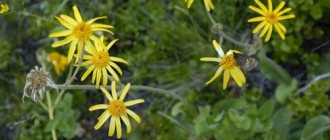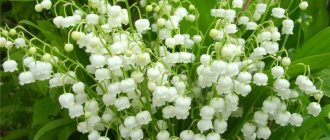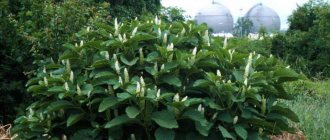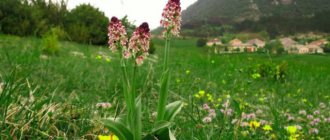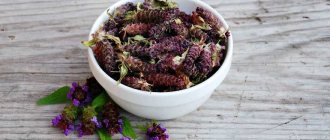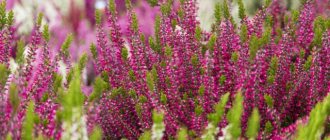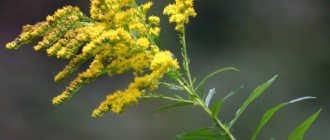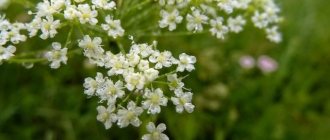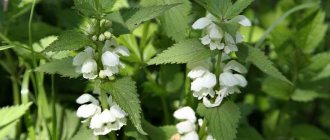Galega grass, goat's rue: where it grows, what it looks like - photo
Galega is a herbaceous plant that reaches no more than a meter in height. This is a fairly powerful herb with odd-pinnate foliage. Galega flowers are bell-shaped and come in shades of lilac, blue and purple. The plant is better known as goat's rue .
It is interesting that after flowering the plant is capable of producing fruits in the form of beans with seeds. The grass begins its wild flowering in late May, early June. Flowering continues until September. Grass grows everywhere , but most of all it loves swampy or lake areas, river banks and the shade of tall bushes.
Galega has long been recognized as a medicinal plant. is actively used in large quantities , but not by traditional medicine. All parts of the plant are used: flowers, leaves and even galega seeds. The grass is dried and stored in canvas bags. It is customary to crush the seeds and sift the husks.
Galega is a very useful plant with many medicinal properties.
Chemical composition and benefits
Galega grass is a useful plant that is actively used to treat diabetes. The upper parts of shoots with flowers are used as medicinal raw materials. Ripe seeds are also often used for therapeutic purposes.
The harvested raw materials contain the following valuable components:
- Alkaloids – the herb includes peganine and galegin;
- Compounds containing nitrogen;
- Saponins;
- Carbohydrates;
- Tanning components;
- Bitter substances;
- Ascorbic acid;
- Flavonoids;
- Rutin;
- Quercetin;
- Kaempferol;
- Phenolcarboxylic acids.
Despite the large number of medicinal properties of galega, it is poisonous. Therefore, the herb has many contraindications for use.
Galega seeds contain fewer active components compared to shoots. However, beans contain additional substances - fatty oils, steroids, sucrose. The fruits also contain valuable acids - linoleic, palmitic, stearic.
Since galega contains alkaloids, this makes it very dangerous to health. Therefore, therapy can only be carried out under the supervision of a doctor.
Galega officinalis, goat's rue: medicinal properties
The plant has several varieties. For example, “eastern goat’s rue” is a plant most often found in forests or forest-steppe. The plant is noteworthy in that it is actively used by people to treat diabetes .
For diabetics, galega helps lower blood sugar . To do this, decoctions and infusions should be prepared from the plant. However, like any herbal medicine, goat's rue is effective only in the initial stages of the disease.
Not only diabetics can regularly use decoctions and infusions of goat's rue. The decoction can improve digestion and even promote the natural release of toxins from the body. That is why this remedy is used to get rid of worms , various parasites, and treat intoxication and poisoning. In addition, the plant has a powerful diuretic effect .
The leaves of the plant are considered unique in their properties . They can be consumed fresh, adding to vegetable salads. The herb has a beneficial effect on lactation in nursing women and increases milk flow. Galega leaves can also be used as an antibacterial agent in the presence of abrasions, wounds, scratches and ulcers on the skin.
Galega is actively used in traditional medicine
Beneficial features
All parts of the herb contain alkaloids, which determine the medicinal effect of the herb.
Additionally contains:
- Saponins;
- Tannins;
- Glucosides;
- Bitterness;
- Organic acids;
- Mineral salts.
The following were found in galega seeds:
- Fatty acids, including palmitic, stearic, linolenic;
- Saponins;
- Alkaloids;
- Steroids;
- Sucrose.
The green part of the goat's rue contains the alkaloids luteolin and galegin.
Goat's rue owes its medicinal properties to guanidine compounds, which are responsible for the mild hypoglycemic effect.
The plant contains chromium salts, which support the action of insulin and guanidine derivatives. As a result, the element helps lower blood sugar levels.
In addition, galega reduces the absorption of glucose and other simple six-carbon carbohydrates, vitamin B12 and folic acid in the small intestine.
The popular antidiabetic drug metformin was originally produced from goat's rue.
Guanidine itself is an organic chemical compound from the imine group with basic properties and strong toxicity potential. Guanidine substances present in goat's rue include galegin and hydroxy-4-galegin.
The plant is also a source of the quinazoline derivative peganine.
Galega herb for diabetes: application
Decoctions and infusions of galega have a beneficial effect on people with diabetes. The unique properties of the plant can reduce the amount of sugar in the blood and improve the body's metabolic processes . Everything happens thanks to the active substance of the plant - galegin.
You can use goat's rue without any special restrictions, because it has no specific contraindications . The course of treatment takes approximately half a year. During this time the patient's health improves , and a decrease in cholesterol is observed. However, people with high blood pressure should take it with caution.
Galega improves the well-being of people with diabetes
Recipes for preparing medicines from galega:
Preparation of the decoction:
- For the decoction you should use galega seeds or crushed dry plant.
- You will only need one teaspoon of the mass, which should be steamed in a glass of boiling water.
- The glass with herbs and boiling water is covered with a saucer and left for about two hours.
- This medicine should be taken before each meal, two tablespoons.
Galega should be taken no more than four times a day, also taking into account the fact that a strong diuretic effect can be achieved.
Preparation of tincture:
- To treat diabetes mellitus, you can also prepare a tincture with alcohol.
- This tincture should be prepared in one to one proportions. For half a glass of the dry part of the plant, use half a glass of vodka or alcohol.
- The medicine is infused for about a week in a dark and cool place. After this it is stored in the refrigerator.
- The tincture should be taken in twenty drops and only after meals.
- The course of treatment with galega tincture should not exceed thirty days in a row.
The infusion should be taken with caution because it can increase blood pressure.
Galega infusion with blueberry leaves:
- Approximately 50 grams of dry galega herb, mint and blueberry leaves should be crushed.
- The dry part is filled with boiling water, half a liter (two glasses)
- In this state, the components are infused for about an hour.
- After infusion, the liquid must be filtered
- You should drink the infusion half a glass a day
- You should take breaks in the monthly course of treatment for ten days
Folk treatment of diabetes with goat's rue
Galega has healing properties that allow the herb to be used for various pathological conditions. According to traditional medicine recipes, goat's rue is used for the following purposes:
- increased glycogen levels in the liver;
- normalization of blood pressure;
- improving lactation;
- resistance to bacteria and viruses;
- providing anti-inflammatory effects;
- reducing sugar concentration;
- normalization of cholesterol levels;
- prevention of plaque formation in blood vessels;
- improving metabolism and brain activity;
- relieving swelling;
- accelerating skin regeneration;
- removal of toxins and parasites;
- normalization of the functioning of the digestive organs.
Important! The use of Galega officinalis is recommended for type 2 diabetes. This is due to the presence of alkaloids in goat's rue.
The use of galega for the treatment of diabetes is associated with the following properties:
- acceleration of glucose breakdown;
- increasing the sensitivity of tissues to the effects of insulin;
- normalization of the pancreas;
- accumulation of glycogen in the body in the required quantity.
Goat's rue can be taken in different ways. One of the effective forms is a decoction. To prepare it, 2 tablespoons of galega are poured with half a liter of water. The composition is boiled for 15 minutes (in a water bath). Before taking, filter the broth and add boiling water to get 500 ml of the product.
Drink 70 ml of goat's rue decoction before meals several times during the day.
Infusion
Mix 25 g of the following ingredients in a container:
- dried goat's rue;
- nettle;
- bean pods;
- dandelion roots.
The composition is poured with boiled water (1 glass per tablespoon). The product is infused for 1 hour.
The infusion obtained from a mixture of herbs and dried galega is divided into 2 doses and drunk before meals.
Tincture
The product allows you to control blood glucose levels, improve metabolic processes, and remove toxic substances and waste from the body. To prepare the tincture, 100 g of goat's rue is poured with 100 ml of vodka or alcohol (70%). The mixture is placed in a dark and cool place and kept for 10 days. Then the product is filtered using gauze and placed in the refrigerator.
Take tincture 20 drops 30 minutes before meals
Juice and essences
You need to take freshly cut goat grass. The juice is squeezed out using any available means for treating wounds. The liquid must first be diluted with water in a ratio of 1:3.
Goat's rue juice can be used to gargle to relieve inflammation.
The essence is used to normalize the functioning of the gastrointestinal tract and treat hemorrhoids. Pour 20 g of galega leaves and flowers into a glass of chilled water and cover with a napkin. The goat's rue remedy is infused in the sun during the day. Then the liquid is filtered using gauze. Before use, add water to obtain 200 ml of essence. The drug is drunk several times a day.
Goat's rue can be brewed and drunk to increase lactation. A tablespoon of dry herb is poured with boiling water and left for 30 minutes.
Tea is taken three times a day, 100 ml
The greatest effect from the use of the herb is observed in the initial stage of the disease. With compensated diabetes, the combination of herbal medicine and proper nutrition allows you to minimize drug treatment. Therapy with goat's rue, like other medicinal plants, is a long process.
There will be no immediate stabilization of glycemia. The condition of a diabetic can be normalized only with regular treatment and compliance with the correct dosage of the herb. Galega for diabetes can be used as a monomedicine or in combination with other folk remedies.
Recipe No. 1
Dried rue leaves - 1 tbsp. l., seeds - 1 teaspoon. pour into a thermos, brew with boiling water (250 ml). It is recommended to do this in the evening. In the morning, filter the finished infusion into a jar. Drink before main meals (about half an hour before). The dose is for one day.
Recipe No. 2
Pour crushed goat grass seeds, in the amount of 1 teaspoon, into a container convenient for cooking, pour boiling water (250 ml). Boil for five minutes over low heat or a water bath. Pour into a thermos and leave for a couple of hours. Filter the resulting medicine. A single serving is a tablespoon before meals. Special instructions for taking this remedy include the fact that the seeds have a fairly strong diuretic effect.
Recipe No. 3
Fill a dark glass bottle with dried rutka inflorescences, add vodka or medical alcohol diluted in half with water. Keep in a dark place for a month. You should take 15-20 drops per dose after meals. Course therapy with alcohol tincture lasts no more than a month.
Recipe No. 4
Mix dried grass stems and leaves in a 1:1 ratio. Next, they need to be ground using a coffee grinder. The resulting powder is not brewed, but taken in dry form. The medicine should be washed down with plenty of warm water. If well tolerated, the powder can be used as a seasoning for diabetic dishes.
Recipe No. 5
Mix rue and dry blueberry leaves in equal quantities. The mixture must be ground and half the resulting volume of dried nettle leaves added to it. Brew a tablespoon of the mixture with a glass of boiling water. Steam for 5 minutes in a water bath and leave. The volume is designed for two doses. Should be consumed before meals.
Galega seeds can be used in the treatment of diabetes
Recipe No. 6
Take a tablespoon of dandelion, nettle, goat's rue, blueberry and lingonberry leaves. The collection is mixed well. To prepare a daily portion of the medicine you will need 1.5 tbsp. l. mixture and 300 ml of boiling water. Drink three times a day before meals.
Recipe No. 7
Dried beans and rue leaves, 50 g each. Brew 400 ml of boiling water. The infusion is kept for an hour and taken 100 ml three times a day before meals. When purchasing ready-made preparations, you should carefully read the composition, since there may be an individual intolerance to one or more components.
Therapy for diabetes mellitus is permanent. Diabetics are forced to take medications and follow a diet for life. Traditional medicine is a worthy helper for maintaining health and preventing severe diabetic complications. Patient reviews of diabetes treatment with galega indicate positive results.
Galega tincture: recipe
Galega infusion is very easy to prepare. All you need to do is pour boiling water over the dry part of the plant and give the grass the opportunity to “saturate” the liquid with beneficial properties.
A simple infusion recipe:
- The medicine should be infused based on the proportions: one teaspoon per glass of boiling water.
- When infusing, the container should be covered with a lid.
- The galega should be left to steep for a couple of hours. It is advisable to do this in a thermos, wrapping it up for two hours.
You can supplement the infusion with any other components: mint, lemon balm, linden, acacia, chamomile, depending on the desired result.
How to brew an infusion of galega?
Diabetes mellitus: use of goat's rue
It should be noted that the goat's rue grass, the photo of which you see below, has proven itself in the treatment of the initial manifestations of type 2 disease. This is explained by the fact that in the initial stage, as a rule, insulin is not used, and diets and folk remedies can help normalize blood sugar levels.
Goat's rue is a herb whose use causes active fluid movement. But in diabetes, not only the hypoglycemic effect is important. Of great importance is the ability of this herb to significantly increase the sensitivity of tissues and cells to sugar.
The herb goat's rue (for diabetes) is attractive primarily because it does not cause sudden changes in blood glucose levels. Goat's rue (galega) in type 2 diabetes takes part in another vital process. As you know, the liver is a “storehouse” of glucose, the role of which is played by glycogen. When the body begins to experience an acute lack of energy, it begins to use hidden reserves, which this herb helps to preserve.
The herb goat's rue (for diabetes) is also important because it strengthens and tones the internal smooth muscles. This makes it easier to remove bad cholesterol and effectively restore blood vessels, which is very important for diabetes.
Article on the topic: Almond willow - beneficial properties, description
Galega preparation: syrup, balm – application
Galega syrup is actively used in the treatment of many diseases. You can buy it at the pharmacy, but it is much easier to prepare it at home. For preparation, natural honey (not sugar syrup) is useful.
Preparation:
- A glass of the dry part of the plant should be poured with two glasses of boiling water and put on low heat.
- The broth should be evaporated until the water is reduced by half.
- After this, the mass is filtered through cheesecloth.
- The decoction is mixed with a glass of natural honey and mixed thoroughly.
- The syrup is poured into jars and used for treatment
Syrup made from galega is a medicine
Seed decoction
In the treatment of this serious illness, not only goat's rue grass is used. A decoction of the seeds also helps with diabetes. It's easy to prepare. Pour a teaspoon of seeds into 200 ml of water, bring to a boil and leave on low heat for five minutes. After this, let the composition brew (about two hours), strain, and squeeze out the raw materials.
You need to know that goat's rue can be consumed in dry form (powder): 0.5 g twice a day. The powder is prepared from the dried leaves of the plant. It is simply washed down with water. Patients suffering from diabetes note that goat's rue grass is really effective. Both decoctions and infusions can be used for diabetes. However, everyone who still uses this plant today does not recommend starting treatment without consulting a doctor.
Galega for lactation: application
As already mentioned, galega has a positive effect on the lactation process in nursing women. To achieve a good effect, you can consume fresh leaves of the plant or cook a decoction. Even a simple infusion by pouring boiling water over the leaves or flowers.
Galega decoction should be taken before each meal. It should be taken into account that galega is a plant product. That is why you should take the decoction carefully, in minimal portions , paying attention to your well-being and the well-being of your child.
Galega decoction can cause an allergic reaction if consumed in excess. In the worst case, if a person has increased individual sensitivity, galega can be toxic.
Galega improves lactation during breastfeeding
Galega officinalis (Galega officinalis)
Syn: goat's rue officinalis, goat's rue, goat's rue, French lilac, wild malt.
A herbaceous perennial plant reaching a height of one meter. In folk medicine, galega is recommended primarily for mild forms of diabetes. The plant has anti-inflammatory, antimicrobial, tonic and diuretic properties.
Table of contents
Flower formula
In medicine
Galega officinalis is not a pharmacopoeial plant and is not used in official medicine, but is approved as a raw material for the production of various biological additives. In folk medicine, galega is one of the most popular remedies recommended for patients with mild diabetes. Galega is also popular for enhancing lactation. The plant has a diuretic, diaphoretic, antimicrobial and anti-inflammatory effect. It is also taken prophylactically as a general tonic.
Contraindications and side effects
Before using galega, it is worth remembering that the plant is poisonous. You should strictly follow the prescribed dosage and do not take goat's rue without consulting your doctor. Galega has contraindications. Among them are pregnancy, hypertension, and individual intolerance to the plant. Since decoctions and infusions of goat's rue, when taken for a long time, significantly disrupt the intestinal microflora, it is necessary, after completing the course, to restore it with special preparations.
In other areas
In agriculture, galega is valued as a forage plant, like all legumes, an extremely protein-rich, natural, nitrogen-containing green fertilizer, and also as an excellent honey plant, whose bright flowers begin to attract bees from the end of May. Gardeners also love goat's rue for its bright flowers; they also like the bright greenery of the plant, which remains this way until the first autumn frosts.
Classification
Galega officinalis is a perennial herbaceous plant from the genus Galega, belonging to the legume family, also known as Moths (Fabaceae). Scientists include 5 to 8 species in the genus Galega, also known as Goat's Rue, but only two of them - Galega officinalis and Galega orientalis - are well-studied, cultivated plants with numerous varieties and garden hybrids.
Article on the topic: Oakwood aconite (antivorous) - beneficial properties, description
Botanical description
Goat's rue officinalis is a perennial herbaceous plant that grows up to one meter in height. The root of galega is taprooted, straight, penetrates 0.6 - 0.9 m deep. The rhizome is equipped with root suckers, there are up to 18 of them, located horizontally in all directions. The stems of the plant are branched, numerous, straight, with dense foliage. Galega leaves are petiolate, odd-pinnate, with stipules, reaching 20 cm in length, they have a pointed apex. Even when they dry out, the galega leaves do not fall off. Goat's rue flowers form dense clusters up to 25 cm in length, each inflorescence contains from 5 to 20 inflorescences. They are blue-violet, gray-violet or bluish. The formula of the goat's rue flower is P(5)L1+2+(2)T(9)+1P1. The fruit of the plant is a non-cracking and non-falling bean, which usually contains from three to seven smooth, kidney-shaped, greenish-yellow seeds.
Spreading
The homeland of Galega officinalis is the Middle East, then the plant was naturalized throughout Europe and Western Asia. Goat's rue grows along river banks, along roads, in valleys and subalpine meadows, along forest edges and in mountain steppes, in beech and subtropical forests. In Russia, galega can be found in the Black Sea and Lower Volga regions; the plant grows in Ukraine, the Caucasus and Moldova.
Procurement of raw materials
The medicinal raw materials are the stems, flowers, leaves and seeds - the aerial part of the goat's rue. They begin to harvest galega from the end of May, during flowering, cutting off the tops up to 20 cm long. Then, from the beginning of June, as it ripens, it is time to collect ripened seeds. Goat's rue grass is dried in the shade in the open air. The raw material is considered ready when the stems stop bending and begin to break. Galega grass can be stored in a closed container for up to 1 year. The seeds of the plant are dried in beans in the sun, the dry beans are placed in bags, then threshed with sticks, then sifted through grates, winnowing the flaps.
Chemical composition
Galega contains alkaloids, saponins and other nitrogen-containing compounds: 4-hydroxygalegin, galegin.
The roots contain triterpenoids; alkaloids, carbohydrates, peganin, vasicinone and other nitrogen-containing compounds were found in the plant's grass: tannins, kaempferol, pipecolic acid, ascorbic acid, rutin, flavonoids, quercetin, carotene, bitter substances, galegin, tannin, phenolcarboxylic acids and their derivatives in hydrolyzate (p-coumaric, caffeic, ferulic, synapic), the seeds of the plant contain sucrose, steroids, stachyose, alkaloids, saponins and other nitrogen-containing compounds, fatty oil, as well as acids: stearic, linolenic, linoleic, palmitic.
Pharmacological properties
For a long time, scientific medicine has carefully studied galegin, one of the main active ingredients of galega officinalis. It has been experimentally revealed that this unique alkaloid is capable of having a hypoglycemic effect; it inhibits intestinal motor function, enhances lactation, and causes vasoconstriction. When administered intravenously, galegin increases blood pressure, and when administered locally, it causes constriction of the pupils. Another alkaloid contained in Galega officinalis - peganine, also known as vazicin - is capable of inhibiting the activity of true and false cholinesterase, toning the smooth muscles of the intestines, and has a choleretic and laxative effect. This alkaloid is not unique; in addition to galega, it is found in a number of plants and was well studied at the beginning of the 20th century. The galega extract itself was also subject to experimental study. It has been proven that it is able to increase the body's tolerance to glucose, inhibits renal insulinase and increases glycogen content in the liver.
Scientists do not deny that the plant, due to its chemical composition, is capable of having lactogenic, diuretic, anthelmintic, anti-inflammatory, antimicrobial and diaphoretic effects. They also do not deny that in the early stages of diabetes, decoctions, infusions and preparations with goat’s rue can reduce blood glucose levels and can partially replace insulin.
Use in folk medicine
Traditional medicine recommends using galega for diabetes, hypotension, to enhance lactation in nursing women, as a diaphoretic for fevers and as a diuretic. To combat worms, prepare a decoction from a mixture of goat's rue seeds and grass. An alcoholic infusion of galega herb is recommended as a general tonic that has a beneficial effect on the functioning of the heart muscle. A decoction of goat's rue in combination with other plants is used externally to treat various skin diseases. Trophic ulcers and inflamed wounds are washed with fresh plant juice. In homeopathic dilution, galega is considered not only an antidiabetic agent, but is also used in the treatment of hemorrhoids.
Historical reference
Galega officinalis found its use back in the Middle Ages. It is known that from the beginning of the 17th century the plant was widely used by European herbalists, in particular German and French, as a lactic, diaphoretic and diuretic. It was no secret that goat's rue had a positive effect on patients with diabetes. It is worth noting that the property of galega to enhance milk lactation was in demand even earlier. It is because of this that the plant got its name “gala”, in ancient Greek - milk, and “ega” - expelling. Since peasants often used galega to enhance lactation in small domestic animals, mainly goats, the plant’s second official name, goat’s rue, and many similar folk names also became commonly used.
The alkaloid galegin, isolated from goat's rue by the French pharmacist and chemist Georges Tarne in the early twenties of the last century, was used in clinical trials on patients with diabetes. Although they were not successful, it was later work with galegin and related compounds that led to the discovery of metamorphine, which became the most important drug in the treatment of this disease.
Article on the topic: Liverwort - beneficial properties, description
Literature
1. Pastushenkov L.V., Pastushenkov A.L., Pastushenkov V.L. “Medicinal plants. Use in folk medicine and everyday life", St. Petersburg. "BHV-Petersburg", 2012- 70 p.
2. Lavrenova G.V., Onipko V.D. “Encyclopedia of Traditional Medicine”, St. Petersburg, Publishing House “Neva”, 2003 - 48 p.
3. Lavrenov V.K., Lavrenova G.V. “Encyclopedia of medicinal plants of traditional medicine, St. Petersburg, Publishing House “Neva”, 2003 - 52 p.
4. Nikulshin V., Kshnikatkina A., Gushchina V. “Purple field on the Penza fields”, magazine “Science and Life”, No. 7, 1993 - 148-149 p.
Galega, contraindications for use
If small portions of galega improve lactation in nursing women, then even minimal portions of herbal decoctions and infusions during pregnancy can cause poisoning. Therefore, doctors strongly recommend not to use medicines from this plant during pregnancy.
In addition, in no case should you exceed the doses of drugs from galega . This herbal component can have a negative effect on those who have problems, as well as diseases of the digestive system.
The most negative effect of galega is the ability to increase blood pressure . Under no circumstances should patients with hypertension be treated with decoctions and infusions of this herb, so as not to provoke a hypertensive crisis.
Galega decoction should not be taken during pregnancy
Contraindications
The beneficial properties of this plant are unique. However, doctors also indicate a list of contraindications. First of all, drugs based on galega should not be taken by pregnant women. Such drugs are also contraindicated for those who have hypotension and hypertension. You should not take drugs from galega if there are any disturbances in the functioning of the intestines. In other cases, the plant has a positive effect on the body. The main thing is to strictly follow the dosage and not self-medicate.
Goat's rue is used for the treatment and prevention of various pathologies. For example, you can take galega if you have diabetes.
It should be remembered that the medicinal herb affects the tone of the stomach. If you have diseases of the digestive system, it is advisable to refrain from using the plant.
Goat's rue helps increase blood pressure. It cannot be used in the form of tinctures or decoctions for hypertension. Taking medications during pregnancy can cause pregnancy interruption and bleeding.
Galega is not used for anemia or urinary tract diseases. Contraindication for use is children under 6 years of age.
In some cases, reactions may occur indicating goat's rue intolerance:
- headache;
- disorders of the digestive system;
- rash.
Galega for diabetes: reviews
Vadim: “Of course, galega is not a panacea or a miracle that will instantly get rid of the disease. But personally, I want to say that this herb is quite capable of giving a little relief. I often felt dizzy, had a dry mouth and nausea every morning.”
Marina: “I made it a habit to drink the decoction at every meal and felt relief. I advise, if you don’t get treatment, then at least try to alleviate the unpleasant symptoms of diabetes with the help of galega.”
Zhenya: “It is galega that helps me cope with stage 2 diabetes. The decoction, which I take three times a day, helps me keep my sugar level and feel “even” throughout the day.
Why take goat's rue grass?
People began to use this wonderful medicinal plant back in the Middle Ages. Initially, the ability of the grass to increase milk yield in livestock was noticed, so it began to be added to feed. It is because of this that its name came about - “goat’s rue”.
Over time, scientists have studied the active ingredients of galega. They came to the conclusion that the main active ingredient, galegin, inhibits intestinal motility, enhances lactation in nursing mothers, and constricts blood vessels.
Peganine contained in the plant is an excellent diuretic and diaphoretic. But it is especially important that it normalizes blood sugar levels. For this reason, the plant began to be used in the treatment of diabetes. Today, many doctors do not deny the beneficial effects of galega-based drugs as part of complex therapy in the treatment of this terrible disease.
Medicinal properties of the plant
Due to its composition, goat's rue has the following effects:
- effectively reduces blood glucose levels;
- has a strong diuretic effect;
- improves lactation;
- strengthens the walls of blood vessels;
- removes harmful cholesterol from the body;
- used to strengthen and increase the tone of the smooth muscles of internal organs;
- normalizes fluid circulation in the body;
- has a beneficial effect on the gastrointestinal tract;
- improves liver function;
- causes increased sweating;
- has an antiparasitic effect;
- has an antibacterial effect.
The properties of the plant are widely used in folk medicine. Various medical preparations are produced on its basis, including Dali’s Secret with Galega and the herbal balm Galega for diabetes.
Experts in the field of traditional medicine believe that the use of goat's rue is especially effective for type 2 diabetes.
Experts in the field of traditional medicine believe that the use of goat's rue is especially effective for type 2 diabetes.
Remedies from the leaves of the plant reduce blood sugar levels.
Goat's rue helps improve the functioning of the pancreas.
Remedies from the leaves and seeds of the plant reduce blood sugar levels. Since insulin is not used in this type of pathology, the amount of glucose must be regulated using diet, herbal and medications. Goat's rue effectively solves the problem for type 2 diabetes. It increases the body's tolerance to glucose, helps improve the functioning of the pancreas, and promotes the accumulation of glycogen in tissues in case of lack of energy.
Regular use of home remedies contributes to stable sugar levels and normal well-being of diabetics.
According to recommendations for the use of medicinal herbs, galega should be harvested during the flowering period, if you need to collect flowers and leaves. In central Russia this is July-August. Seeds are collected only after full ripening, so that they have time to accumulate a maximum of useful substances.
The stems of the plant are cut at a distance of 10-15 cm from the ground on fine days. It is necessary to dry the raw materials in the open air under a canopy until the leaves begin to break easily.
The raw material retains its properties for 1 year; it must be stored in fabric bags.
If discomfort occurs after taking the medicine, you should stop taking it and seek advice from a doctor.
An alternative name for the medicinal goat's rue is galega. The presented plant belongs to the legume family and is in demand in all countries of the former USSR. The presented powerful branched grass boasts leaves that are arranged unpaired and at close distances to each other. In their shape they resemble brushes.
The flowering time of goat's rue begins in the summer and continues until the arrival of calendar autumn. After which, in place of the buds, seeds are formed, namely beans, due to which the plant reproduces. Goat's rue, as you know, prefers to grow on damp soil, as well as in lowlands, along the edges of small reservoirs.
DETAILS: What are the benefits of fish oil? Beneficial properties of fish oil, possible harm and contraindications
No less often it can be found surrounded by various bushes that cast extensive shadow. The plant is named goat's rue because it is fed to herbivorous domestic animals and is grown specifically for this purpose. In folk medicine, all parts of the plant are used:
- flowers;
- leaves;
- seeds;
- stems reaching a height of 1.5 meters.
In folk medicine it has a wide range of uses. Alkaloids (galegin and leganin) are released from the seeds of the plant. This allows you to increase blood pressure and increase the level of secretion of the mammary glands.
Dried herbal part of the plant and flowers:
- Used in the form of infusions.
- Like a good diuretic.
- Antibacterial agentj.
- Against worms.
- Helps lower blood sugar levels.
- Used for mild forms of diabetes.

